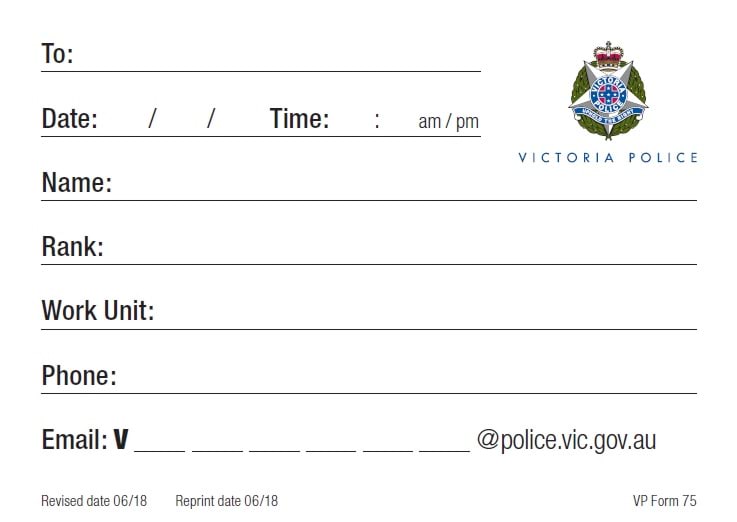A contact card is a resource that police and protective services officers (PSOs) can use to provide their details and information about support services to members of the community.
An example of a contact card is below:


About contact cards
Learn about contact cards, and what to do if you are given one.
Your contact card will tell you:
- the police or protective services officer's name and work area
- the date and time
- how to access the Victims of Crime Helpline
- translation and interpreter services
- how to provide a compliment or complaint about the services you received.
Police and protective services officers may use contact cards in a wide range of interactions with community. For example, they can provide you with information on who you spoke with, when this occurred and what it related to.
They may also include information to assist you with further enquiries or support. For example, you may be witness or victim of a crime and need to provide further details to police or a protective services officer about the incident at a later stage.
If a police or protective services officer asks you for your name and address, you are also entitled to ask them for their details.
You can ask for their name, their rank and the police station where they work.
You can request these details in writing.
Depending on the situation, police may use a contact card to write their details.
For more information about speaking to police, visit Victorian Legal Aid - police powers and my rights.
The contact card is a record of your interaction with Victoria Police.
It is not a legal document and you are not required to keep it.
Victoria Police introduced contact cards as part of our commitment to transparent and accountable policing.
The card provides police and protective services officers a resource to provide you with:
- a record of your interaction with police
- assistance with access to services
- information about how to make further enquiries.
- Arabic(opens in a new window)PDF 320.07 KBBurmese(opens in a new window)PDF 63.47 KBDari(opens in a new window)PDF 139.21 KBDinka(opens in a new window)PDF 128.37 KBFarsi(opens in a new window)PDF 136.07 KBGreek(opens in a new window)PDF 144.76 KBHindi(opens in a new window)PDF 184.06 KBItalian(opens in a new window)PDF 128.31 KBKaren(opens in a new window)PDF 37.87 KBMandarin(opens in a new window)PDF 72.68 KBNuer(opens in a new window)PDF 151.49 KBOromo(opens in a new window)PDF 130.48 KBPashto(opens in a new window)PDF 181.31 KBPunjabi(opens in a new window)PDF 168.44 KBSomali(opens in a new window)PDF 23.61 KBSpanish(opens in a new window)PDF 23.32 KBTurkish(opens in a new window)PDF 130.47 KBVietnamese(opens in a new window)PDF 136.38 KB
Updated